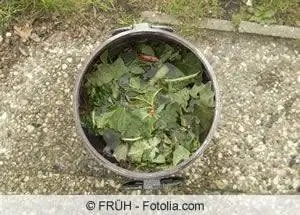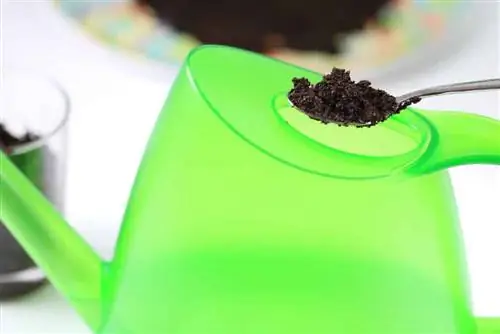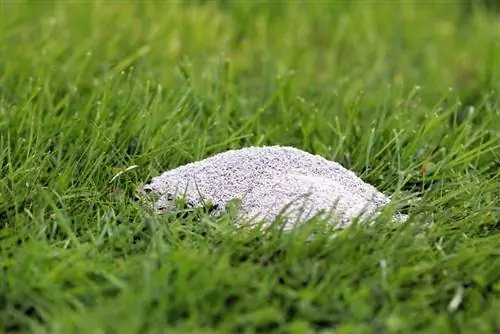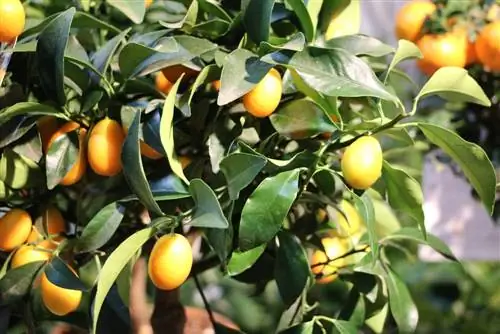- Author admin [email protected].
- Public 2023-12-17 03:39.
- Last modified 2025-06-01 06:48.
In this regard, farmers and hobby gardeners agree; Liquid fertilizer is the future. The list of positive properties compared to solid fertilizers is long and convincing. While commercial plant cultivation continues to use mineral preparations without concern, environmentally and he alth-conscious recreational gardeners favor organic fertilizers. The previous problem of independently producing liquid fertilizer is gradually disappearing, thanks to a we alth of experience that has been accumulated. Find out about all the benefits of liquid fertilizer here. Benefit from useful tips for making.
All advantages at a glance
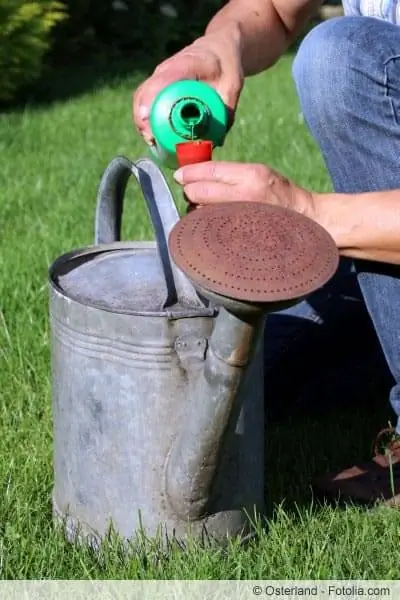
Providing the plants in the house and garden with the nutrients they need in liquid form only has advantages, even if you look more closely. The following overview shows the central aspects:
- Nutrients are immediately available to the plants
- More even distribution compared to granulate spreaders
- No need for laborious raking of granules into the soil
- no harmful dust is produced
- no investment in expensive gritters required
- More precise dosage possible, accurate to the milliliter
- no risk of chemical burns on dry ground
- immediate elimination of nutritional disorders thanks to foliar fertilization
- Effective coverage of seasonal demand peaks in nutrient supply
Plants and gardeners benefit equally from liquid fertilizer. In this context, the work organization aspect may also be of interest, because the application of solid fertilizer is significantly more dependent on the weather.
Make your own liquid fertilizer - useful tips
For a long period of time, nature-loving hobby gardeners were faced with the problem that they could only derive the benefits of liquid fertilizer from commercially available mineral-chemical preparations. The large community of recreational gardeners was not deterred by this circumstance and experimented with natural ingredients until they discovered how, for example, liquid compost could be made. An extensive body of important knowledge has now emerged on how liquid fertilizer can be produced for allotment gardens without dealing with chemical toxins. The following tips for manufacturing provide an overview of the current state of knowledge.
Plant manure - a natural liquid fertilizer
Stinging nettles are rich in nitrogen, comfrey provides potassium, horsetail broth prevents fungal diseases; The list of plants that have effective ingredients is long. With just a few simple steps and a little patience, they transform into intensive plant manure, the ideal biological liquid fertilizer for the entire garden. Their production always follows the same principle:
- collect one kilogram of fresh leaves from non-flowering plants
- mix in a wooden tub with 10 liters of water (rain or pond water)
- cover with wire mesh or a grid to prevent animals from falling in
- Set up in a sunny, secluded garden spot and stir daily
- After the 14 day fermentation process, strain the mixture
If you have previously avoided making plant manure as a liquid fertilizer because of the bad smell, use the following tips to effectively reduce the odor:
- Add rock dust, bentonite or Humofix with each stirring process
- Chamomile, valerian or oak leaves also have an odor-reducing effect
- additional oxygen through an aquarium pump at the bottom of the vessel drives away the stench
You can save yourself the hassle of straining a plant liquid after the fermentation process if the plant material is placed in an old curtain or net in the vat. In this case, the leaves cannot clog the aquarium pump.
Tip:
Plant manure is generally used in a highly diluted form. As a liquid fertilizer for the root area, the manure is diluted with water in a ratio of at least 1:10. For foliar fertilization, watering in a ratio of 1:50 is recommended.
Modify compost into liquid fertilizer
Mature compost represents the ultimate organic fertilizer for the kitchen and ornamental garden. It contains all the nutrients that a lushly growing plant needs without having to add the slightest chemical ingredient. Due to its nature, its range of applications was for a long time limited to bed soil, where compost is incorporated with a rake. So that your potted plants can also enjoy natural nutrition, turn mature garden compost into liquid fertilizer using the following method:
- Pour 1 liter of sifted compost into a wooden tub.
- Pour 5 liters of water over it and stir.
- Add a spoonful of primary rock flour to vitalize the microorganisms.
- Place at the outer end of the garden and cover.
After 2 to 3 days, the home-made compost is ready for watering. To do this, strain the liquid without stirring the mixture again.

Make your own liquid flower fertilizer
So that the bouquet in the vase presents its lavish blooms for a long time, additional nutrients such as nitrogen, potassium and phosphorus are essential. The same applies to flowering and evergreen houseplants. In the service of the environment, hobby gardeners also decide to use liquid fertilizer that they produce themselves. The most popular examples:
- Potato water: used when cooled as irrigation water, it releases valuable nutrients
- Stale beer: this contains a we alth of nutritious components that develop when watered
- Baker's yeast: dissolve a fresh yeast cube in 10 liters of water and use it to water the plants
- Cola or coffee: provides plants in acidic soil with important nutrients and lowers the pH value
- Egg water: used as irrigation water, it supplies the flowers with calcium and oxygen
- Soda: 1 tablespoon dissolved in 2 liters of irrigation water once a month, ideal for lime-loving plants
You therefore already have a variety of ingredients for liquid fertilizer in your home. In this context, it should not be overlooked that an immediate effect on the flowers and plants cannot be expected. If administered consistently, the desired effect will still develop over time.
Liquid fertilizer for the lawn
A lush green carpet of lawn cannot develop without a sophisticated supply of additional nutrients. When using lawn fertilizer in granular form, there is always the risk of over-fertilization. With an organic liquid fertilizer you can revitalize the grasses without risking chemical burns or burns. Beetroot manure has proven to be extremely effective here. Ferment 1 kilogram of leaves and stems in 10 liters of water for 14 days. Apply this natural lawn fertilizer twice a week after particular strain or after a new plant, diluted in a ratio of 1:10. The green area will recover splendidly and grow thickly within a short period of time.
Conclusion of the editors
Liquid fertilizer impresses with powerful advantages, such as a rapid effect and uncomplicated application. In order to enjoy the numerous positive attributes, a hobby gardener is not forced to resort to commercial mineral preparations. Thanks to simple recipes, compost can be modified into liquid fertilizer, just like nitrogen-containing nettles or potassium-rich comfrey leaves. The inevitable stench is significantly reduced by adding rock dust or the targeted supply of oxygen using an aquarium pump. If you shy away from this effort, you can use a variety of home remedies to use their nutrients as liquid fertilizer for flowers.
What you should know about liquid fertilizers in brief
Liquid fertilizer has the advantage over solid fertilizer (e.g. fertilizer sticks) in that the fertilizer penetrates directly into the soil and immediately supplies the roots with nutrients.
Phosfic
- The liquid fertilizer Phosfik is a phosphorus and potassium-based fertilizer for fruit, wine, vegetables and ornamental plants.
- Phosfic ensures a targeted nutrient supply to the cultures with all main and trace elements.
- The liquid fertilizer strengthens the resistance and improves the color, aroma and taste of the fruits.
- Another advantage is that the liquid fertilizer supports the formation of the plant's own defense substances. Phosfik may only be used diluted.
Protamine
- Protamine is a liquid fertilizer in which copper is complexed with amino acids and humic acids.
- This means that copper is actually absorbed by the plant. The organic components promote growth.
- The advantages of the liquid fertilizer protamine are disease prevention and cell division is promoted.
- The fertilizer is suitable for fruits, vegetables and herbs.
Boromin
- Boromin is a new liquid fertilizer with ten percent boron based on boronethanolamine.
- The amino acids it contains increase adhesion and reduce herbicide infestation.
- Boromin is suitable for fertilizing rapeseed, sugar beets, potatoes and vegetables.
Vitalet
- Vitalet is a special foliar fertilizer with highly effective calcium.
- It strengthens the cell wall tissue, has a revitalizing effect and brings significant quality improvements.
- It ensures the targeted supply of nutrients in the event of calcium deficiency symptoms such as internal burn in lettuce, fruit rot in tomatoes and speck in apples.
- Vitalet is particularly suitable for fertilizing salads, for example lamb's lettuce or leaf lettuce.
Rizammina
- Rizammina is a unique organomineral fertilizer for efficient foliar fertilization in fruit and wine growing.
- The liquid fertilizer ensures improved fruit and tuber size.

